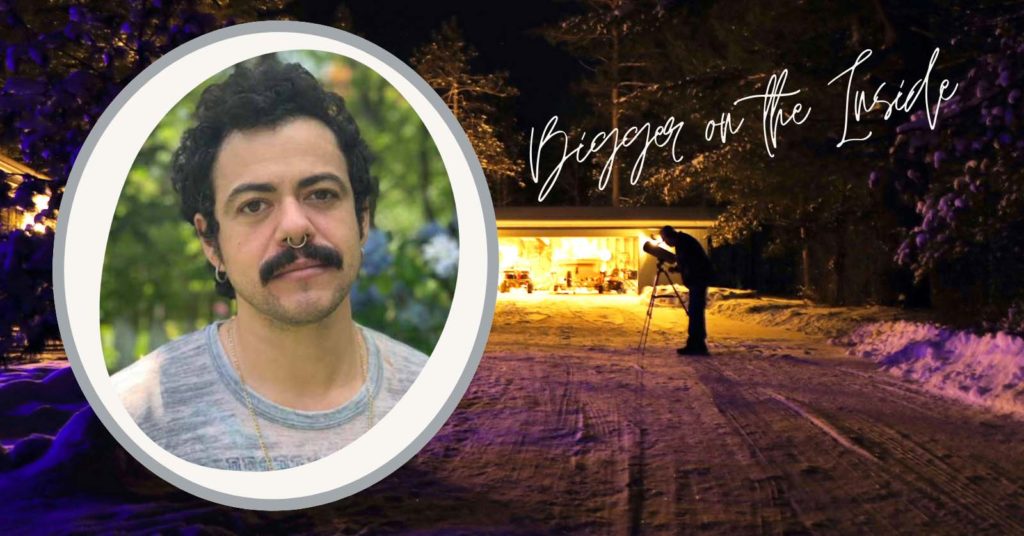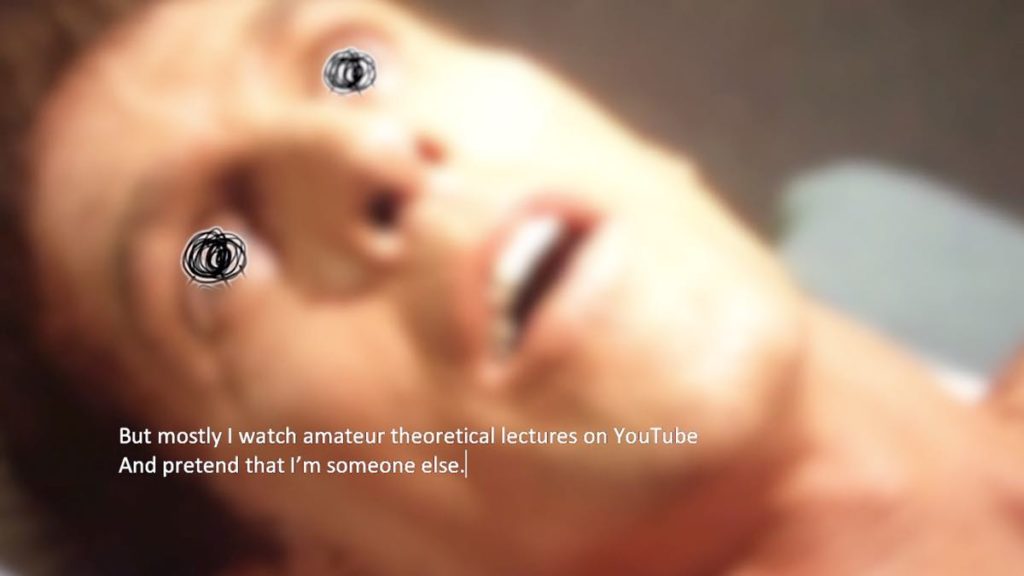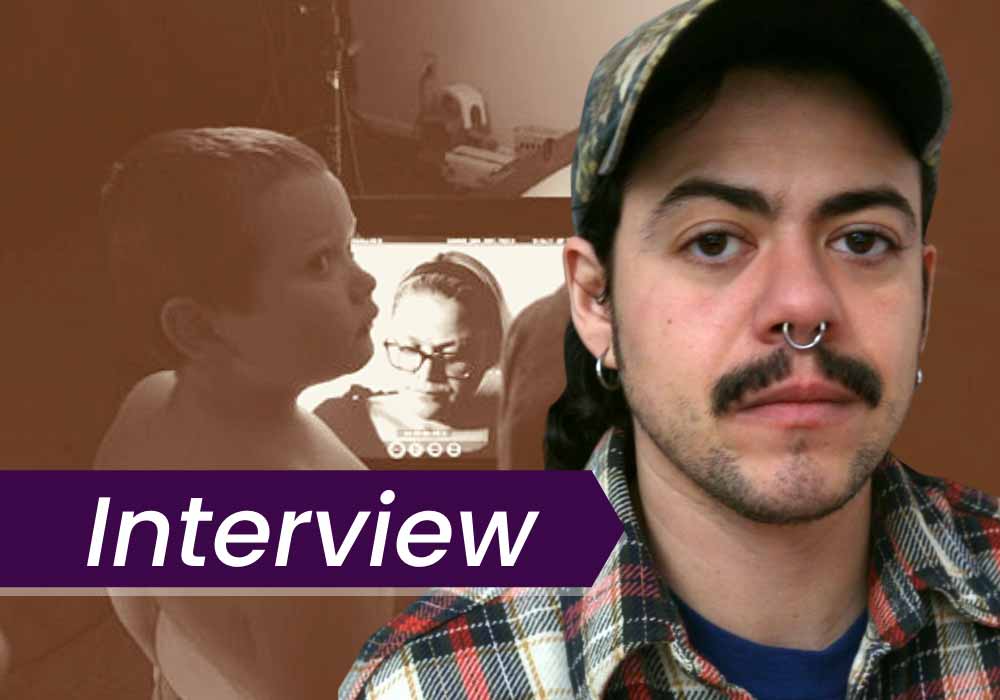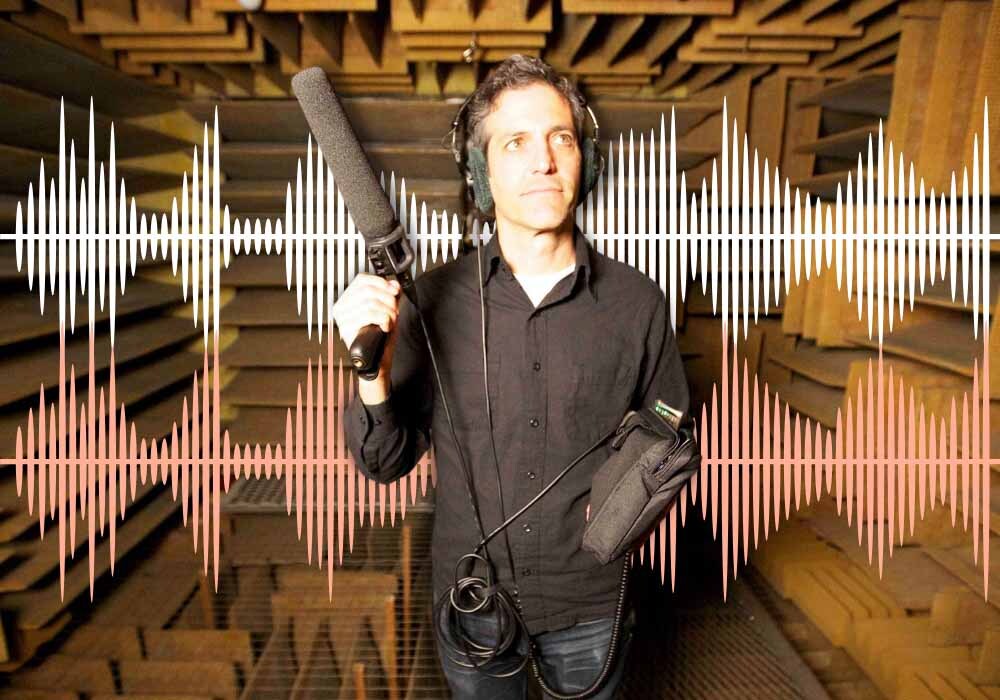In this interview with Angelo Madsen Minax (North by Current), he discusses his new short film, Bigger on the Inside, a work of creative nonfiction film, which premiered at TIFF.
Read all of our TIFF 2022 coverage here.

Discover one film you didn’t know you needed:
Not in the zeitgeist. Not pushed by streamers.
But still easy to find — and worth sitting with.
And a guide to help you do just that.

Don’t miss out on the best films on the fall film festival circuit
Join our FREE newsletter today to become a Seventh Row inside. You’ll get updates on how to see the best under-the-radar films, up-to-the-minute updates from our festival coverage, and tips on where to catch these near you.
Angelo Madsen Minax’s Bigger on the Inside is a travelogue into the psyche of Minax — or perhaps the character of Minax, as the film is fully scripted — as well as a direct dialogue with the audience. The film is part photographic montage, YouTube video montage, text message exchanges, animation, text typed to the audience, and flights of fancy. It’s a film about loneliness, searching for identity, discomfort in identity, spending time in nature, going down rabbit holes on the internet, and looking to connect with others but being afraid or unsure to do so.
You might call it an essay film, but you feel like you’ve jumped into his head, John Malkovich style. Bigger on the Inside is densely packed with ideas and has some of the greatest laugh-out-loud moments — both of ‘dialogue’ (in text form) and images. It’s also, at turns, sad, contemplative, and searching. You’ll want to watch it back immediately.

Download the first two ebook chapters FREE!
Explore the spectrum between fiction and nonfiction in documentary filmmaking through films and filmmakers pushing the boundaries of nonfiction film.
Bigger on the Inside is scrapbook cinema at its best: a collection of thoughts, ideas, and feelings that offer insight into a character we almost never see, know almost no identifying details about, and yet get to know very intimately. It opens with an image made in After Effects that looks like the window of an attic looking out on a snow-covered landscape. A montage of photographs of wintery trees that appear to be taken at different times of day over many days, makes time itself feel blurry — well before onscreen text explains that this is how the protagonist feels.
A man glimpsed only from afar gazes at the stars. Next, a simulation of a black hole plays out as a text exchange on an app like Scruff plays out, transforming the image from one of cosmic contemplation about the universe and the meaning of life, into a sexual one. The text exchange gets funnier and funnier as Minax’s character gets more desperate, leading to a fantastic line I won’t spoil.
From there, the film follows Minax’s character through what he’s been thinking, watching, and reading — very much mimicking the process of making the film. But we only glimpse Minax himself briefly in a couple of selfies, and hear his unidentified voice, offering a dodgy theoretical lecture on desire and triangles, midway through the film.
A departure from North by Current
There’s a mashup of music and ideas, all perfectly paced to ebb and flow in the way that solitude, desire, obsessions, and loneliness do, too, in the film. Although somewhat of a departure from his first documentary feature, North by Current (2021), which was more explicitly personal nonfiction, Minax describes Bigger on the Inside as very much in his wheelhouse, following ideas of the macro (the cosmos, or infrastructure seen from above) and the micro of personal desire previously explored in his short films, like The Eddies (2018).
Bigger on the Inside is exactly the kind of film for which we need the term ‘creative nonfiction’. It joyfully plays with the form of documentary, and challenges you to question the boundaries between fiction and nonfiction — both in this film and more generally. In our 2021 ebook on creative nonfiction, Subjective realities, Part 5 of the book asked, “Does nonfiction filmmaking have the power to heal?” North by Current felt like it continued that conversation that other filmmakers started in our book.
With Bigger on the Inside, Minax more explicitly plays with the question in Part 2 of Subjective realities: “Where is the line between fiction and reality?” Although North by Current also played with this question, featuring reenactments which were not clearly delineated, it is very much the subject of Bigger on the Inside. Not only does Minax ask the audience to question what is real or fiction, but he raises questions about his own protagonist’s ability to distinguish between the two in his own life.
After the world premiere of Bigger on the Inside at the Toronto International Film Festival, I sat down with Angelo Madsen Minax for an interview to discuss the inspirations for the film, his working process, finding the structure and pacing of the film, and why it’s tripping people up into thinking it’s a pure documentary. Our conversation is a continuation of the one that began with Executive Orla Smith when she talked to Minax about North by Current.
Dreaming up the film Bigger on the Inside
7R: Where did the idea for the film come from?
Angelo Madsen Minax: When I started thinking about Bigger on the Inside, I was working with a couple of Emily Dickinson poems. I was doing a bunch of shit that ended up being stepping-stones to the real thing, which is often how these kinds of projects unfold. A lot of the work I did on this film two years ago is not in the film anymore. I would consider that research. Research is how I arrive at the work.
I was also thinking through desire, and this idea of the crisis of human contact. It sounds so trite, but it was April 2020, when I was in my apartment, just chilling. I was having a romance with a person who I’m still with. We were remote dating the whole time. How can I understand it through an emotive framework, or an intellectual framework? How can I find some humour, or some joy, in the fact that there’s some sorrow here?
I was working with this idea of triangles and hunger and how I could position these ideas together. Some of that, obviously, is still evident in the film. There’s an entire lecture that’s based on triangles. That was one of the earlier things I did that stayed in the film. I built the film around it. When I first recorded it, the lecture was almost thirty minutes long, but it’s now very, very whittled down.
After I had the lecture, and I worked through the triangles, I couldn’t really find a good landing place. So, I just let it sit, which is what I often do with my work.
Returning to the film Bigger on the Inside with the benefit of time for reflection
I left it for a year, not really doing anything with it while I was finishing North By Current. I also made two other films in 2021. After North By Current was finishing its festival run, I staged all these telescope photographs with my dad. In February or March of this year, I just decided that I was going to finish that film that I had started. I went back in and put it together. Then, I brought in a lot more cosmos imagery and the footage of the telescope stuff and the star-scapes.
I had pieces and parts that felt connected: the meme, the ending, the lecture, and the triangle section at the beginning. I wanted to feature the relationship between interior and exterior architecture, micro and macro.

Don’t miss out on the best films on the fall film festival circuit
Join our FREE newsletter today to become a Seventh Row inside. You’ll get updates on how to see the best under-the-radar films, up-to-the-minute updates from our festival coverage, and tips on where to catch these near you.
On the importance of returning to short filmmaking
7R: After making your first feature, you’re back in the world of experimental shorts with Bigger on the Inside.
Angelo Madsen Minax: I love getting to work on shorts like this. It reinvigorates my usual working process, which is actually pretty different from how I worked on North By Current. The tangential weaving is part of the process in a film like Bigger on the Inside.
I’ve worked on [Bigger on the Inside] for two years, but very inconsistently. That’s how my last few short projects have arrived at completion. I just pick them up when I feel motivated to do so and put them down when I feel stuck. That is a great working process for me.
Films like this cost nothing to make, except my time and labour, which is valuable. But I’m not beholden to anyone else’s financial needs when I work on a film like this. It really lets me do my process the way I want to do my process. That’s not only good for the work, but it’s also good for the pleasure factor. I get inspiration from things I’m reading or watching, and thinking about how that relates or connects to what I’ve started.
On truth vs nonfiction in the film Bigger on the Inside
7R: I recall you telling me that the New York Film Festival had initially billed the film as a documentary, and you felt that was incorrect. When you sent me the film, you wanted to make sure I knew that it was scripted.
Angelo Madsen Minax: I read the text that the New York Film Festival had put in the description of the film, and they had fully interpreted it as a documentary, more or less. And I was like, you can’t write that, that’s not real. I don’t want that to be misleading.
This is a scripted film. It’s not scripted in the way that you would think of a narrative film. It’s not written and then filmed; it’s written during filming. And it’s written in the editing. It is written, and it does involve structuring in an editorial process. It is not cinéma vérité.
Obviously, I’m interested in questions of truth. Otherwise, I wouldn’t make that so murky. I’m trying to instil those questions and then give the viewer enough of a discord to understand that something is awry here. They should be questioning the level of truth, not swallowing it passively. They should be engaged the whole time.
So, I just rewrote [the description] and sent it back to [NYFF]. It was just interesting to me, as that’s part of the whole meat of the film. There is this muddiness between truth and fiction, and that’s part of what is exciting about working in this way. But to firmly position it as nonfiction, I think, is misleading.
On documentary vs. nonfiction
7R: You play a version of yourself in the film Bigger on the Inside.
Angelo Madsen Minax: It was a fun process to play a character [in the film], which I think I do in a lot of my short work when I’m starring in it. In The Eddies (2018), and in this film, I play a similar character, which is this version of myself that is maybe a sliver of myself, but it’s not me, you know? I tend to pull these facets out of my own experiences in the world and create character around them.
7R: Tell me about the opening image of the film. It kind of looks like a gallery space with snow on the inside. You talk later about hanging out in attics looking at the snow.
Angelo Madsen Minax: I do a lot with artificial interiors and artificial exteriors, as well. That’s a completely digitally rendered space. There’s nothing real about it. It’s images, and compositing. It’s After Effects work. I like creating environments that way. It is supposed to be reminiscent of the attic window I was looking out earlier. You have to give viewers something to gnaw on [laughs].

Download the first two ebook chapters FREE!
Explore the spectrum between fiction and nonfiction in documentary filmmaking through films and filmmakers pushing the boundaries of nonfiction film.
7R: I know you don’t want the film Bigger on the Inside to be called a documentary. Do you feel like it’s not nonfiction, as well? How important is the line between fiction and nonfiction in the film to how you classify it?
Angelo Madsen Minax: Ultimately, I would just call it a film. That works best for me. If you want to talk about creative nonfiction or hybrid formats, that’s fine. A lot of documentary festivals are embracing hybrid forms and forms of nonfiction that also include some fiction.
It’s interesting to be on the radar of the documentary world now, in this way that doesn’t totally align with my work, usually. Places that have serious social impact mission statements want to look at my screener. And I’m like, no you don’t, trust me. The big word for these places is ‘change.’ They’re asking, how are we going to instil change?
For me, change comes from inculturation experience, individual and collective growth. It doesn’t come from a film talking at you about what you should do next. As much as I think a lot of these organisations do amazing work, I also have a lot of hangups with them.
On using text instead of voiceover in the film Bigger on the Inside

7R: In North By Current, you were playing a lot with voiceover. You talked to Executive Editor Orla Smith about that in her interview with you. In the short film Bigger on the Inside, aside from the lecture, there isn’t much heard voiceover. But there’s a lot of text: the text messages between you and a romantic partner and the text on screen to us, where it feels as if you’re writing to the audience.
Angelo Madsen Minax: One of my favourite things to do is to play with these different voices, and different methods of address. I like the interplay of what the audience is privy to, and what the audience is not privy to. I feel like that’s classic narrative filmmaking: what do you let the audience in on, and what do you conceal from the audience? What do you let the characters in on about each other, and about their world? In this way, I think the film uses a lot of those canonical narrative tropes.
The text [messages with the romantic partner] for me was assembled from the position of using an app like Scruff. The character that I am embodying is one with high needs for intense experience. To me, there’s some dissonance there, and the level of energy being put out in the world is not conducive to, or is not appropriate to, the intimacy of the relationship. It’s someone who is way too much, too fast.
On conversations with yourself
The responses [my character is] putting out are clearly about what I’m projecting out into the world about what I need versus what I want from this other person. I think that’s how most people like to engage, even when they think they’re having a conversation with someone. They’re really in conversation with themselves most of the time. I think that the Scruff texts really play with that idea. And that’s all scripted, none of that is a real conversation.
It’s this idea of putting yourself out into the world, to nobody. It reminds me of the days of ChatRoulette. You could spin the internet wheel and end up in a chat room with anybody, from anywhere in the world. Everyone is there for a different reason. I feel that way about apps, too. Even though there’s this idea that we’re all there to connect, I think we’re all there for different reasons.
Connection is fleeting: not whimsical, but impermanent. We’re only getting our needs met for a fraction of time, if we’re getting our needs met at all. I like playing with that platform [Scruff]. I like picking up the tone of the onscreen text. At certain moments, it feels like a reflective voice, like the voice of a journal or a diary. At other points, it feels like a direct audience address. I like implicating the audience. I do that a lot in voiceover and onscreen text. It’s also a way in which I feel my humour works well. I do really like using onscreen text when I can make it work.
The voiceover in the short film Bigger on the Inside
7R: The one source of voiceover in Bigger on the Inside is the YouTube theoretical lecture on desire and triangles, which you narrate, though you don’t signal that it’s you. It could just as easily be one of the many YouTube videos you talk about watching.
Angelo Madsen Minax: People who don’t know me, of course, don’t know that it’s me delivering the lecture. It’s sort of like an easter egg. If you know what my voice sounds like, you will know that it’s me playing the role of this pop theorist. The lecture is kind of hilarious, because there’s a fine line between saying something smart and having no idea what you’re talking about. The idea for the lecture was about having a semblance of an idea that you gravitate to so hard, but not really being able to theorise it in a cogent way.
I wanted to play with how anybody can talk about shit, as if they know what they’re talking about. I’m trying to pose as if I know what I’m talking about. But at the same time, I’m slipping you signals that show I have no idea what I’m talking about. I like that play.
It’s also one of those ways that facts get disrupted. I’m delivering you information, but then you’re getting all these cues that this information is actually quite murky. I like that dissonance. I like that push for a viewer to have to ask questions of truth. You’re not actually getting high theory here, even though it might be disguised as such. You’re getting a lot of blabbing. And I think that’s funny. But it’s also about the inability to get the thing you want, which is sort of what the whole film is about.
On making films about bodies without showing them
7R: You described yourself as embodying this character, but for the most part, we don’t actually see bodies in the film. We see somebody, from a distance, at the telescope, which I guess is your dad. There’s a few little selfies in the middle. But for the rest, we’re looking at what you’re looking at, or seeing the screens that you’re seeing, or being given some sort of insight into your headspace.
Angelo Madsen Minax: I often think that people, when they think about erotics, sexuality, intimacy, and gender all in the same place, there becomes a very common direct lineage with porn. I like pushing on that, and playing with that. Porn is about excess. What I do is about withholding information, and then a very calculated excess. So, I’m gonna give you one, kind-of sexy selfie in the middle, that’s very fast and doesn’t show anything except a wanton face. That’s the most you get: take it or leave it.
I think resisting the spectacle of the non-normative body has been something that I’ve played with for most of my career. It’s something I continue to play with. And it’s something that I waver on too. Sometimes, I just want spectacle. I want that spectacle to be a little bit of an F-you, to a viewer. Other times, I want to resist and withhold, and not give people the thing they expect, or not give people the thing they want.

Download the first two ebook chapters FREE!
Explore the spectrum between fiction and nonfiction in documentary filmmaking through films and filmmakers pushing the boundaries of nonfiction film.
The Eddies was about an erotic encounter with a guy. I offered his full frontal on screen the whole time. I never gave any of myself, except in these abstract, shower shots that were totally disembodied. It was like a blurry shot of half of an arm. It’s the idea that you don’t get that. And maybe you had an expectation that you would get that.
Work about the body can be so basic, especially when it just translates to the literal body. It’s not uncommon with people who make work about the body, to just see lots of bodies in their work. I think we can ask some harder questions by resisting the path of least resistance. I think there’s other ways to investigate these same ideas that don’t get caught up in reproducing the same types of images of marginalised bodies repeatedly. You wonder, to whose benefit is that for? How much do you reclaim something when you reclaim it? What is that about?

Angelo Madsen Minax on editing Bigger on the Inside
7R: Can you tell me about the editing process?
Angelo Madsen Minax: When I cut the film, it only took a week, and it was done. A lot of my process is just thinking through where pieces fit together. Once I had all the work there, that was it. It is fast, but I’ve been editing it in my head for two years.
I’m a super intuitive editor. I don’t map it out or use post-its; I don’t use spreadsheets; I just play and work. I tried various approaches to mapping with post-its and note boards and all this shit with North By Current. At the end of the day, it just came down to moving pieces around in the timeline. That’s always how I’ve done it best.
I like a nice balance between rupture and flow. Moments of rupture can be really valuable if they’re not overdone. The eyeball sequence, as an example, is a montage that disrupts us and moves us somewhere else while still forming a segue between movements, if you will. I tend to make films that have movements more than acts.
Angelo Madsen Minax on editing to music for Bigger on the Inside
7R: There’s a lot of music in the film. How did that fit into the editing process?
Angelo Madsen Minax: This is my favourite way to work. Because honestly, it’s the least calculated. When I say I was editing in my head for two years. What I really mean is I was thinking about the work. So, I wasn’t thinking of where to put the individual pieces. It was more like: what do I want to do? What do I want to feel? What do I want to see? How do I want to move through ideas? And where are the tangential threads that make this work conversationally? The tissues that connect? Those are usually what I spend time drawing out more so than the movements themselves.
Music can be a motivator to cut. There’s a cemetery a couple blocks from my house, and [most mornings] I would run laps around it. But I would listen to the soundtrack from Trainspotting (1996) and ”Born Slippy” [which plays at the end of Bigger on the Inside] was always at the end of the playlist. Therefore, it was always the song that I would really push to.
I was listening to it a lot and really connecting to it because it was a song that I loved as a teenager. When I would go to raves in high school, I listened to it a lot I feel like most decisions we make about things we use have deep roots in some way, at least for me. And I think for most people, too, even if they don’t cop to it.

Don’t miss out on the best films on the fall film festival circuit
Join our FREE newsletter today to become a Seventh Row inside. You’ll get updates on how to see the best under-the-radar films, up-to-the-minute updates from our festival coverage, and tips on where to catch these near you.
The sound design of the film Bigger on the Inside
7R: Tell me about the sound design.
Angelo Madsen Minax: In the final edit of Bigger on the Inside, I was like, wow, there’s a lot of music here. I didn’t know how I felt about that. In other projects, I have been much more restrained with music. With this one, I really kind of let go. I wanted to make something more playful, more like a mash up. The music has this “amateur hour” effect, in some ways. The worst student films will always be the ones that have songs everywhere, right? I love this idea of novice experiments, which I think factors in well with the lecture and the idea of trying to put language to hard things.
Music is one of our most effective ways to connect with an emotive sensibility and a sense of memory. We know what music is when we hear it. The music under the lecture is this sort of muzak that you would hear on a YouTube tutorial. The music puts us in that place, very quickly. I love drone music, and I love slower music that is super intensely orchestrated, but also minimally executed. So I was using a lot of tracks from my own music library, which I then built upon with effects.
I do lots of sound design on all my projects. Whether or not there’s lots of music, there’s a lot of design going on. I think that it enriches the experience and can also support pace and movement. There’s a sort of swell that happens through the film, from the beginning until we arrive at the black hole. A lot of that is done through pace in the edit, but it’s also done through the sound. Even during the rupture eyeball montage sequence, the sound really reinforces that.
Premiering Bigger on the Inside
7R: How was the world premiere of Bigger on the Inside at TIFF?
Angelo Madsen Minax: I came, and it was great. I’ve had a couple disappointing years with North By Current (2021), not having very robust in-person screenings at times. Just because of bad timing. There were times that I would show up to a screening and there would only be ten people in the audience and it just felt devastating.
So it was really nice to come to a super robust festival as my first screen for this film (Bigger on the Inside). We had a totally sold out audience, and I got to watch people laugh and engage with it. I love being able to see when people laugh out loud. Especially in the experimental film world, because it’s like pulling teeth to get people to smile. So it’s extra amazing when you can hear the whole room: they chuckle, or they kind of sigh, or they laugh out loud. That’s really fun.
Next steps for Angelo Madsen Minax’s Bigger on the Inside
7R: What are the plans for the film going forward? Is it going to eventually be out in the world for people to see if they miss it at one of your festival screenings?
Angelo Madsen Minax: I have no idea. I was recently asked something along the lines of why none of my short films are available. If there was a good outlet for short, experimental films, sure. Let me know when there is one. I think Criterion Channel is doing some interesting work. One of my films is streaming on it, so that’s a great outlet. But otherwise, I’m not going to put my films on YouTube. That’s not in my worldview.
Bigger on the Inside will screen at a number of festivals this fall, including the New York Film Festival, NewFest, the Vermont Film Festival, and as part of a gallery installation at the De La Warr Pavilion in the UK. Keep an eye out for it at your local festivals, as Minax does not have any plans to release the film online after its festival run, and this is not one you’ll want to miss. Keep up with future screenings on Angelo Madsen Minax’s website.

Download the first two ebook chapters FREE!
Explore the spectrum between fiction and nonfiction in documentary filmmaking through films and filmmakers pushing the boundaries of nonfiction film.
Discover more interviews with filmmakers on creative nonfiction films like Angelo Madsen Minax’s short film Bigger on the Inside

Become a Seventh Row insider
Be the first to know about the most exciting emerging actors and the best new films, well before other outlets dedicate space to them, if they even do.




